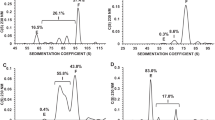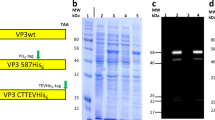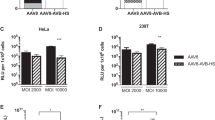Abstract
Adenovirus (Ad) vectors are widely used in gene therapy and in vitro/in vivo gene transfer because of their high transduction efficiency. However, Ad vector application in the gene therapy field is limited by poor transduction into cells not expressing the primary receptor, coxsackievirus and adenovirus receptor. To overcome this problem, several types of capsid-modified Ad vectors have been developed. The HI loop or C-terminus of the fiber knob, the C-terminus of the protein IX (pIX) and the hypervariable region 5 of the hexon are promising candidate locations for displaying foreign peptide sequences. In the present study, we constructed Ad vectors in which each of the above region was modified by a simple in vitro ligation-based method, and examined the characterization of each Ad vector containing the FLAG tag (DYKDDDDK) or RGD (CDCRGDCFC) peptide. Enzyme-linked immunosorbent assay examining the surface expression of foreign peptides on the virus suggested that foreign peptides are exposed on virion surfaces in all types vectors and that the hexon was the most efficiently reacted, reflecting the copy number of the modification. However, in the case of the transduction efficiency of Ad vectors containing the RGD peptides, the modification of pIX and the hexon showed no effect. The modification of the HI loop of the fiber knob was the most efficient, followed by the modification of the C-terminus region of the fiber knob. These comparative analyses, together with a simple construction method for each modified Ad vector, could provide basic information for the generation of capsid-modified Ad vectors.
This is a preview of subscription content, access via your institution
Access options
Subscribe to this journal
Receive 12 print issues and online access
$259.00 per year
only $21.58 per issue
Buy this article
- Purchase on Springer Link
- Instant access to full article PDF
Prices may be subject to local taxes which are calculated during checkout






Similar content being viewed by others
References
Kovesdi I, Brough DE, Bruder JT, Wickham TJ . Adenoviral vectors for gene transfer. Curr Opin Biotechnol 1997; 8: 583–589.
Benihoud K, Yeh P, Perricaudet M . Adenovirus vectors for gene delivery. Curr Opin Biotechnol 1999; 10: 440–447.
Wickham TJ . Targeting adenovirus. Gene Therapy 2000; 7: 110–114.
Mizuguchi H, Hayakawa T . Targeted adenovirus vectors. Hum Gene Ther 2004; 15: 1034–1044.
Bergelson JM, Cunningham JA, Droguett G, Kurt-Jones EA, Krithivas A, Hong JS et al. Isolation of a common receptor for Coxsackie B viruses and adenoviruses 2 and 5. Science 1997; 275: 1320–1323.
Tomko RP, Xu R, Philipson L . HCAR and MCAR: the human and mouse cellular receptors for subgroup C adenoviruses and group B coxsackieviruses. Proc Natl Acad Sci USA 1997; 94: 3352–3356.
Dmitriev I, Krasnykh V, Miller CR, Wang M, Kashentseva E, Mikheeva G et al. An adenovirus vector with genetically modified fibers demonstrates expanded tropism via utilization of a coxsackievirus and adenovirus receptor-independent cell entry mechanism. J Virol 1998; 72: 9706–9713.
Staba MJ, Wickham TJ, Kovesdi I, Hallahan DE . Modifications of the fiber in adenovirus vectors increase tropism for malignant glioma models. Cancer Gene Ther 2000; 7: 13–19.
Mizuguchi H, Koizumi N, Hosono T, Utoguchi N, Watanabe Y, Kay MA et al. A simplified system for constructing recombinant adenoviral vectors containing heterologous peptides in the HI loop of their fiber knob. Gene Therapy 2001; 8: 730–735.
Koizumi N, Mizuguchi H, Utoguchi N, Watanabe Y, Hayakawa T . Generation of fiber-modified adenovirus vectors containing heterologous peptides in both the HI loop and C terminus of the fiber knob. J Gene Med 2003; 5: 267–276.
Dmitriev IP, Kashentseva EA, Curiel DT . Engineering of adenovirus vectors containing heterologous peptide sequences in the C terminus of capsid protein IX. J Virol 2002; 76: 6893–6899.
Ghosh-Choudhury G, Haj-Ahmad Y, Graham FL . Protein IX, a minor component of the human adenovirus capsid, is essential for the packaging of full length genomes. EMBO J 1987; 6: 1733–1739.
Furcinitti PS, van Oostrum J, Burnett RM . Adenovirus polypeptide IX revealed as capsid cement by difference images from electron microscopy and crystallography. EMBO J 1989; 8: 3563–3570.
Rosa-Calatrava M, Grave L, Puvion-Dutilleul F, Chatton B, Kedinger C . Functional analysis of adenovirus protein IX identifies domains involved in capsid stability, transcriptional activity, and nuclear reorganization. J Virol 2001; 75: 7131–7141.
Le LP, Everts M, Dmitriev IP, Davydova JG, Yamamoto M, Curiel DT . Fluorescently labeled adenovirus with pIX-EGFP for vector detection. Mol Imag 2004; 3: 105–116.
Meulenbroek RA, Sargent KL, Lunde J, Jasmin BJ, Parks RJ . Use of adenovirus protein IX (pIX) to display large polypeptides on the virion--generation of fluorescent virus through the incorporation of pIX-GFP. Mol Ther 2004; 9: 617–624.
Li J, Le L, Sibley DA, Mathis JM, Curiel DT . Genetic incorporation of HSV-1 thymidine kinase into the adenovirus protein IX for functional display on the virion. Virology 2005; 338: 247–258.
Vellinga J, Rabelink MJ, Cramer SJ, van den Wollenberg DJ, Van der Meulen H, Leppard KN et al. Spacers increase the accessibility of peptide ligands linked to the carboxyl terminus of adenovirus minor capsid protein IX. J Virol 2004; 78: 3470–3479.
Sumida SM, Truitt DM, Lemckert AA, Vogels R, Custers JH, Addo MM et al. Neutralizing antibodies to adenovirus serotype 5 vaccine vectors are directed primarily against the adenovirus hexon protein. J Immunol 2005; 174: 7179–7185.
Roberts DM, Nanda A, Havenga MJ, Abbink P, Lynch DM, Ewald BA et al. Hexon-chimaeric adenovirus serotype 5 vectors circumvent pre-existing anti-vector immunity. Nature 2006; 441: 239–243.
Vigne E, Mahfouz I, Dedieu JF, Brie A, Perricaudet M, Yeh P . RGD inclusion in the hexon monomer provides adenovirus type 5-based vectors with a fiber knob-independent pathway for infection. J Virol 1999; 73: 5156–5161.
Wu H, Han T, Belousova N, Krasnykh V, Kashentseva E, Dmitriev I et al. Identification of sites in adenovirus hexon for foreign peptide incorporation. J Virol 2005; 79: 3382–3390.
Mizuguchi H, Kay MA . A simple method for constructing E1- and E1/E4-deleted recombinant adenoviral vectors. Hum Gene Ther 1999; 10: 2013–2017.
Mizuguchi H, Kay MA . Efficient construction of a recombinant adenovirus vector by an improved in vitro ligation method. Hum Gene Ther 1998; 9: 2577–2583.
Mizuguchi H, Xu ZL, Sakurai F, Mayumi T, Hayakawa T . Tight positive regulation of transgene expression by a single adenovirus vector containing the rtTA and tTS expression cassettes in separate genome regions. Hum Gene Ther 2003; 14: 1265–1277.
Maizel Jr JV, White DO, Scharff MD . The polypeptides of adenovirus. I. Evidence for multiple protein components in the virion and a comparison of types 2, 7A, and 12. Virology 1968; 36: 115–125.
Caravokyri C, Leppard KN . Constitutive episomal expression of polypeptide IX (pIX) in a 293-based cell line complements the deficiency of pIX mutant adenovirus type 5. J Virol 1995; 69: 6627–6633.
Koizumi N, Mizuguchi H, Hosono T, Ishii-Watabe A, Uchida E, Utoguchi N et al. Efficient gene transfer by fiber-mutant adenoviral vectors containing RGD peptide. Biochim Biophys Acta 2001; 1568: 13–20.
Koivunen E, Wang B, Ruoslahti E . Phage libraries displaying cyclic peptides with different ring sizes: ligand specificities of the RGD-directed integrins. Biotechnology (New York) 1995; 13: 265–270.
Pasqualini R, Koivunen E, Ruoslahti E . Alpha v integrins as receptors for tumor targeting by circulating ligands. Nat Biotechnol 1997; 15: 542–546.
Arap W, Pasqualini R, Ruoslahti E . Cancer treatment by targeted drug delivery to tumor vasculature in a mouse model. Science 1998; 279: 377–380.
Vellinga J, Uil TG, de Vrij J, Rabelink MJ, Lindholm L, Hoeben RC . A system for efficient generation of adenovirus protein IX-producing helper cell lines. J Gene Med 2006; 8: 147–154.
Campos SK, Barry MA . Comparison of adenovirus fiber, protein IX, and hexon capsomeres as scaffolds for vector purification and cell targeting. Virology 2006; 349: 453–462.
Legrand V, Spehner D, Schlesinger Y, Settelen N, Pavirani A, Mehtali M . Fiberless recombinant adenoviruses: virus maturation and infectivity in the absence of fiber. J Virol 1999; 73: 907–919.
Von Seggern DJ, Chiu CY, Fleck SK, Stewart PL, Nemerow GR . A helper-independent adenovirus vector with E1, E3, and fiber deleted: structure and infectivity of fiberless particles. J Virol 1999; 73: 1601–1608.
Acknowledgements
The author thanks Tomomi Sasaki for technical assistance. This work was supported by grants from the Ministry of Health, Labor, and Welfare of Japan. NK is the recipient of a fellowship from the Japan Society for the Promotion of Science.
Author information
Authors and Affiliations
Corresponding author
Rights and permissions
About this article
Cite this article
Kurachi, S., Koizumi, N., Sakurai, F. et al. Characterization of capsid-modified adenovirus vectors containing heterologous peptides in the fiber knob, protein IX, or hexon. Gene Ther 14, 266–274 (2007). https://doi.org/10.1038/sj.gt.3302859
Received:
Revised:
Accepted:
Published:
Issue Date:
DOI: https://doi.org/10.1038/sj.gt.3302859
Keywords
This article is cited by
-
Identification of a novel immunological epitope on Hexon of fowl adenovirus serotype 4
AMB Express (2021)
-
iRGD tumor-penetrating peptide-modified oncolytic adenovirus shows enhanced tumor transduction, intratumoral dissemination and antitumor efficacy
Gene Therapy (2014)
-
Development of fiber-substituted adenovirus vectors containing foreign peptides in the adenovirus serotype 35 fiber knob
Gene Therapy (2009)
-
Re-targeted adenovirus vectors with dual specificity; binding specificities conferred by two different Affibody molecules in the fiber
Gene Therapy (2009)
-
A simple, lanthanide-based method to enhance the transduction efficiency of adenovirus vectors
Gene Therapy (2008)



